Traditional Scottish Shortbread
This post may contain affiliate links. See my disclosure policy.
This traditional Scottish Shortbread recipe creates those perfectly crumbly, irresistibly buttery, and wonderfully delicious shortbread biscuits that have been a year-round favorite treat for centuries. It’s made with just 3 staple ingredients but the flavor and texture is unforgettable!
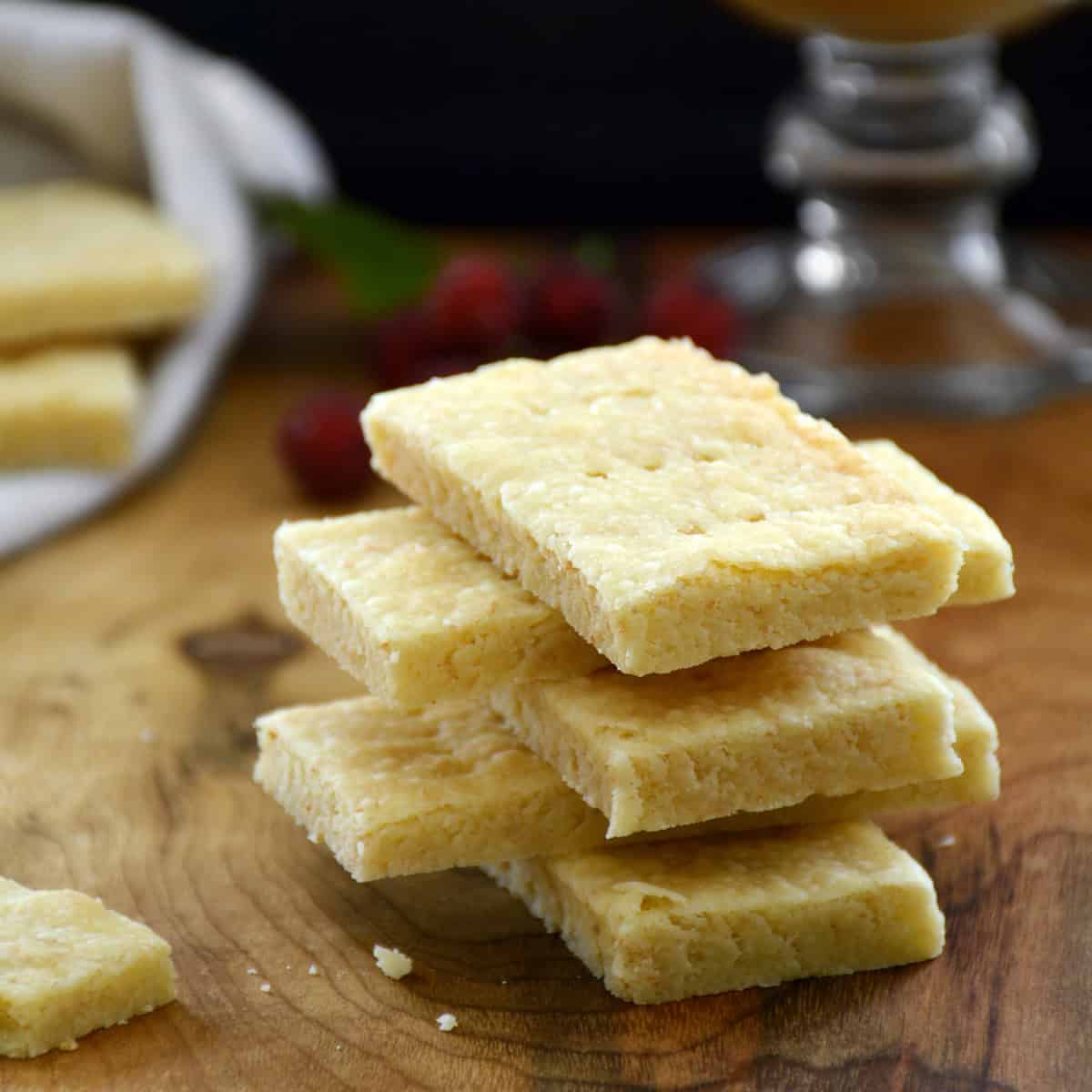
What is Shortbread?
Shortbread is as basic and simple as a cookie (biscuit) can get. But it’s also divinely delicious. And for that reason shortbread has been a favorite throughout the UK for hundreds of years.
The origin of shortbread goes back to somewhere around the 12th century when it was originally made from leftover bread-making dough that was left to dry out and harden into “biscuit bread.” Over time butter replaced the yeast and biscuit bread evolved into shortbread. The term “short” refers to the crumbly texture from the large quantity of butter. Butter was a luxury item and so shortbread was enjoyed only on special occasions and, of course, by the nobles and royals.

The more refined version of shortbread as we know it today is attributed to Scotland, in particular to Mary, Queen of Scots in the 16th century. She was particularly fond of what was known as Petticoat Tails, which was a thin shortbread baked in a large circle and cut into triangular segments. In her day the shortbread was commonly flavored with caraway seeds, which were all the rage in British baking for several centuries. In fact, the earliest published shortbread recipes from the 18th century were more elaborate than the standard shortbread today: They were baked with candied citrus peels and garnished with caraway comfits.
Traditionally Scottish shortbread is baked in either a rectangular or square slab and cut into fingers, as individual round biscuits, or in one large circle and cut into triangles. But you can cut them any shape you like and also use cookie stamps. I have these cookie stamps, these ones, and these ones and love them all – excellent quality.
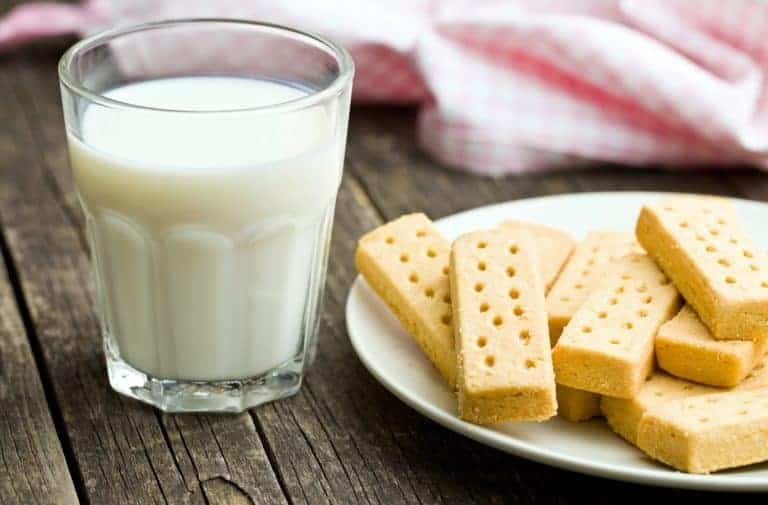
Scottish Shortbread Ingredients
We’re making Scottish shortbread the traditional way with just 3 ingredients: Flour, Sugar and Butter. Well, and a tiny pinch of salt, too. Nothing else is needed, no fancy ingredients, no flavor enhancers. The key to a good Scottish shortbread is the quality of the butter. That is what flavors the shortbread and the shortbread is only as good as the butter.
I’ve read a few claims that “traditional” Scottish shortbread is made with farola, which is a fine flour milled from durum wheat. But the oldest recipes I’ve researched do not, so this “tradition” may be a later/more contemporary one. Likewise some recipes call for powdered/confectioner’s sugar as well as rice flour; neither of these are traditional and should be avoided if you’re goal is to make authentic Scottish shortbread.
Another key to making Scottish shortbread is to use caster sugar. Not regular granulated sugar. Not powdered/confectioner’s sugar. Caster sugar is very fine granulated sugar. Caster sugar is commonly used in British baking and it’s an all-around smarter choice than granulated. The reason is that the sugar crystals in granulated sugar are much larger and take longer to dissolve during baking and may not dissolve completely. Caster sugar dissolves more rapidly leaving a finer texture to the baked good. You can buy caster sugar in the store or very simply make your own buy pulsing granulated sugar in a food processor or blender until it is ground more finely.

Scottish Shortbread Variations
In addition to the three base ingredients of flour, sugar and butter, there are a number of add-ins you can include to flavor your shortbread. Classic options include candied ginger, candied orange peel, dried cranberries or cherries, nuts, chocolate chunks, rosemary, lavender, and you can also dip or drizzle the shortbread biscuits with chocolate.

This Scottish Shortbread recipe is very simple and very easy to make and once you’ve made it yourself there will be no need to buy it again! Before we get started, if you want to take your shortbread to the next several flavor levels, try my traditional Scottish Millionaire’s Shortbread. With layers of shortbread, caramel and chocolate it is the ultimate indulgence! (Incidentally, it’s what my son requests every year for his birthday!)
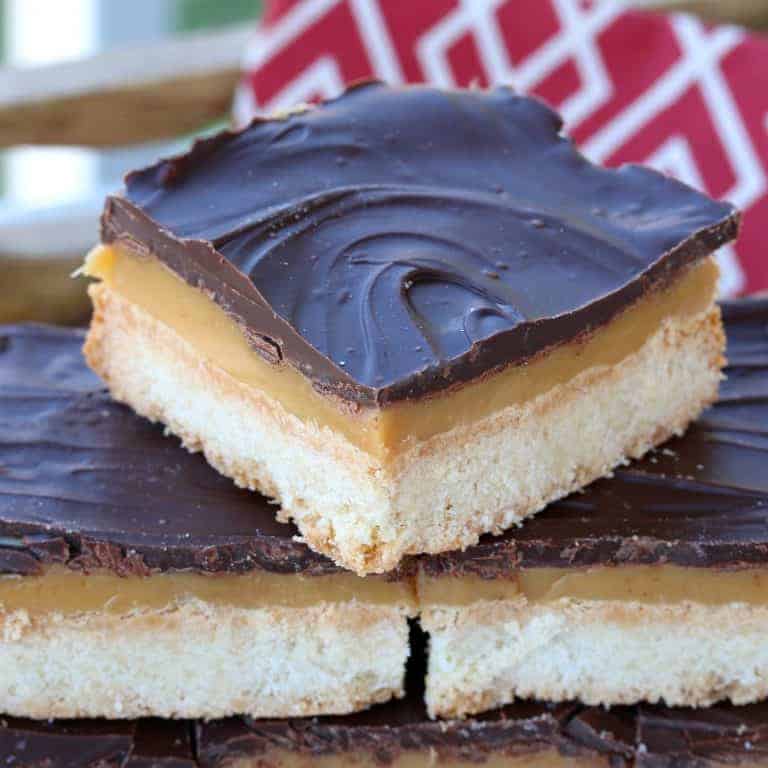
Scottish Shortbread Recipe
Let’s get started!
You can either buy caster sugar (it’s overpriced) or make you’re own, which is what I do. Super easy: Just put the sugar in a blender or coffee/spice grinder and pulse until it’s very fine.
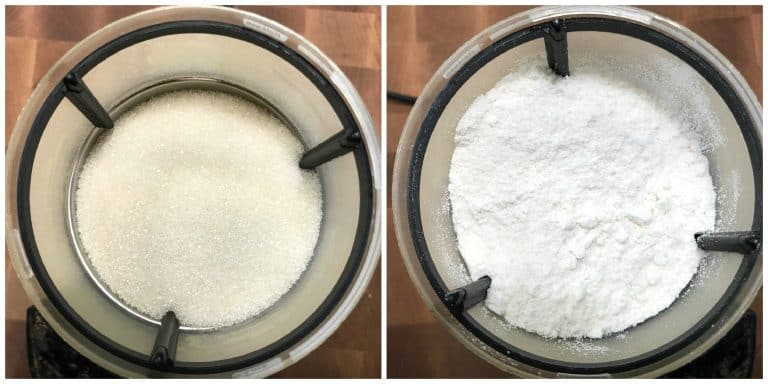
Place the flour, butter, caster sugar and salt in a food processor and pulse until it’s combined and looks like coarse breadcrumbs but is soft and pliable and comes together in a dough when you press it together between your fingers. If it’s too dry and crumbly it needs to be pulsed a bit longer.
At this point stir in any add-ins if using (candied ginger, candied citrus peel, herbs, nuts, etc.)
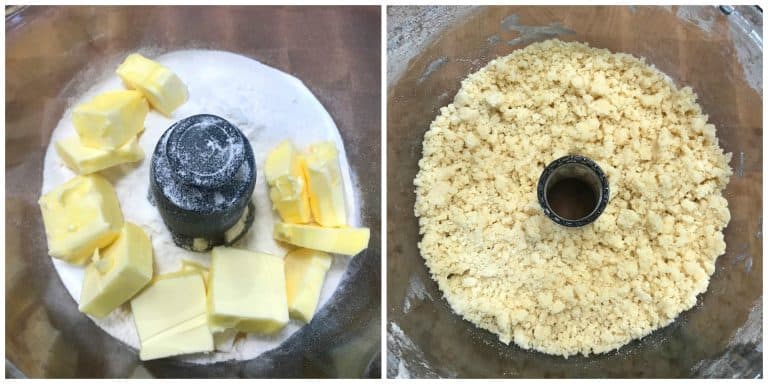
Pour the mixture into a greased 8×8 inch (shortbread roughly 3/4 inch thick) or a 9×9 inch (shortbread about 1/2 inch thick) baking pan. You can also use a round cake pan. Use your fingers and hands to firmly press down the mixture.
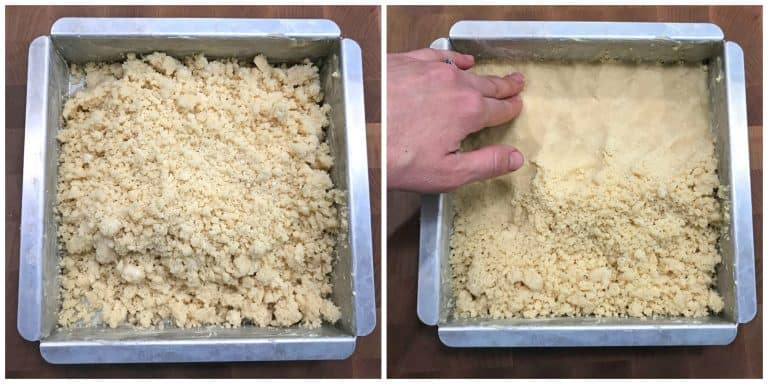
Prick the shortbread with the tines of a fork, creating rows. You can also run a knife between each row of fork tines to make cutting the shortbread easier after it’s baked. Another option is to prick the shortbread with a fork immediately after it is done baking while it is still warm; this way the holes will be more pronounced as they have a tendency to close during baking.
Preheat the oven to 350 degrees F. Place the shortbread on the middle rack and bake for 30-35 minutes or until light golden and firm. Remove from oven and sprinkle lightly with caster sugar or granulated sugar. Let cool. Cut and serve.
Store the shortbread in an airtight container for up to several weeks. Its flavor and texture improves over time.
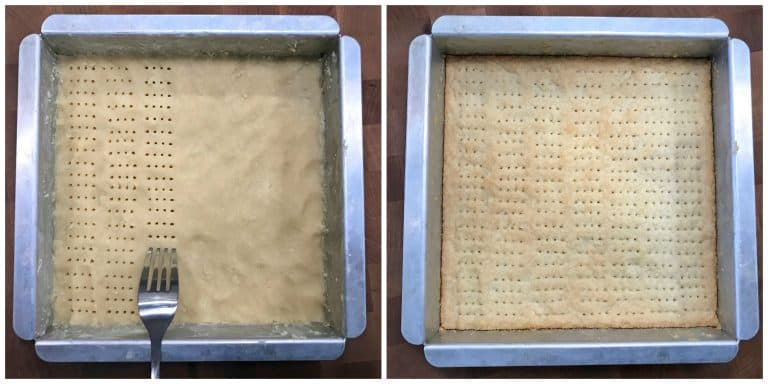
Storage Tips
Shortbread has a low moisture content and so it does best when it’s stored in an airtight container. Cool, dry conditions are optimal to enable the shortbread to retain some crisp without becoming stale. Stored this way it will keep for a few weeks. If you plan on keeping it longer it can also be frozen. To do that, place some parchment paper between the shortbread biscuits to prevent them from sticking to each other. Freeze them in freezer containers or ziplock freezer bags and let them thaw at room temp when you’re ready to eat them. They can be frozen for up to 3 months.
Enjoy!
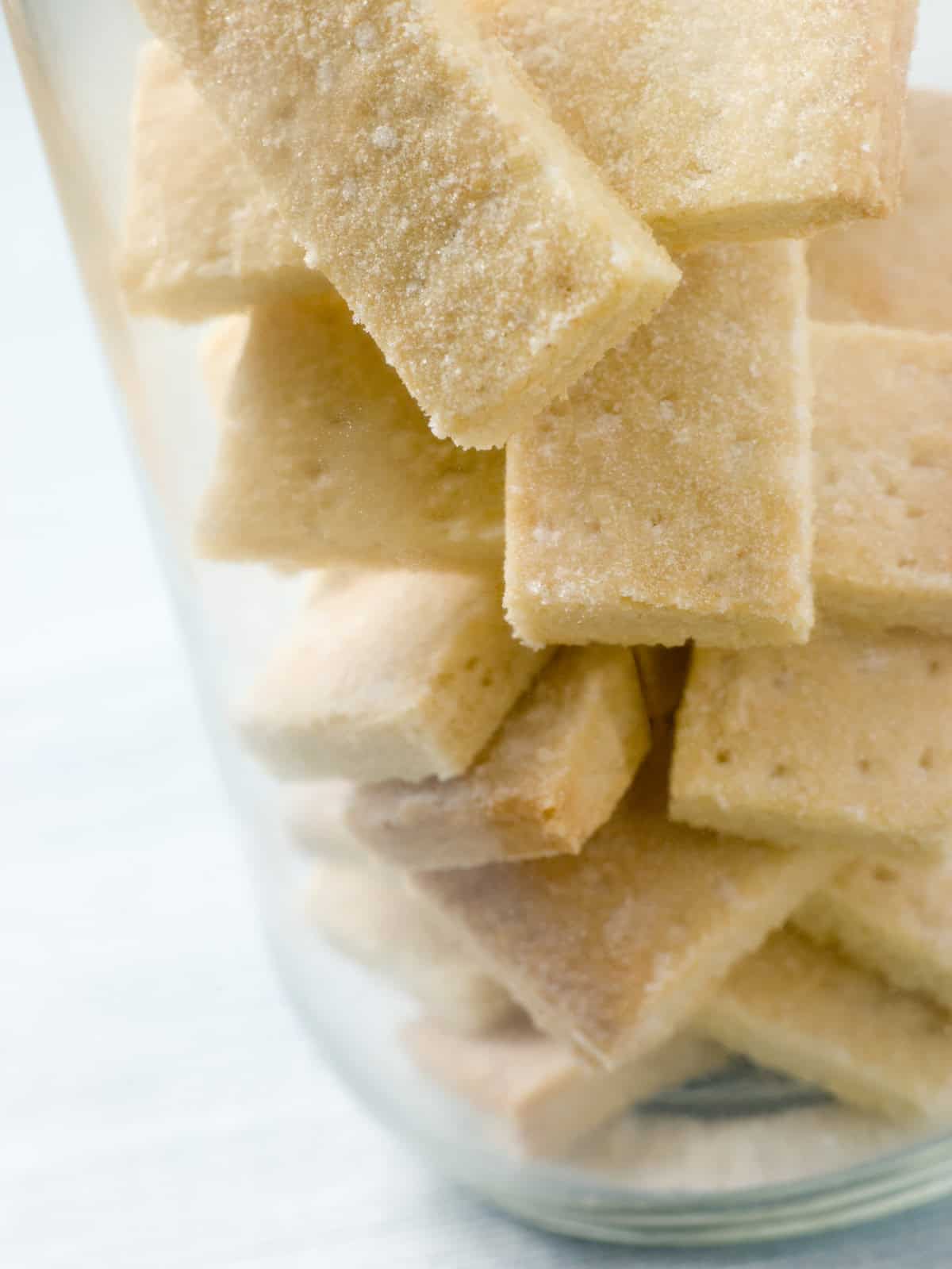
For more traditional British treats try my:
- Treacle Tart
- Sticky Toffee Pudding
- Spotted Dick
- Chelsea Buns
- Lardy Cake
- Eccles Cakes
- Chelsea Buns
- Cornish Fairings
- Hot Cross Buns
- Easter Biscuits
- Parkin
- Bara Brith
- Barmbrack
- Mincemeat
- Mince Pies
- Victoria Sponge Cake
Save This Recipe
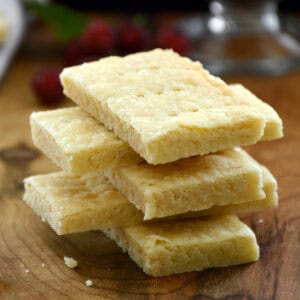
Traditional Scottish Shortbread
Equipment
- Cookie stamps (optional)
Ingredients
- 2 1/2 cups all-purpose flour
- 1 cup quality unsalted butter , cubed and softened at room temperature (the better the butter, the better the shortbread)
- 1/2 cup caster sugar , or "baker's sugar" in the U.S. (if you can't find it simply pulse granulated sugar in a blender until very fine. Do NOT use powdered sugar)
- 1/2 teaspoon salt
- Optional Add-Ins:
- Homemade Candied Ginger (click link for recipe)
- Homemade Candied Citrus Peel (click link for recipe)
- Other options include nuts, fresh herbs, dried cranberries, etc.
Instructions
- Preheat the oven to 350 degrees F. Butter a 8×8 or 9×9 inch square baking pan. You can also use a round cake can and cut the shortbread into triangles.
- Place the flour, butter, caster sugar and salt in a food processor and pulse until it's combined and looks like coarse breadcrumbs but is soft and pliable and comes together in a dough when you press it together between your fingers. If it's too dry and crumbly it needs to be pulsed a bit longer. (If using any add-ins, stir them in at this point.)Pour the mixture into the greased baking pan. Use your fingers and hands to firmly press down the mixture. Note: If the mixture is too dry to work with, including pricking with a fork (see below), then it was not pulsed long enough in the food processor. Prick the shortbread with the tines of a fork, creating rows. You can also like run a knife between each row of fork tines to make cutting the shortbread easier after it's baked. Another option is to prick the shortbread with a fork immediately after it is done baking while it is still warm; this way the holes will be more pronounced as they have a tendency to close during baking.
- Place the shortbread on the middle rack and bake for 30-35 minutes or until light golden and firm. Remove from the oven and sprinkle lightly with caster sugar or granulated sugar. Let cool. Cut and serve.Store the shortbread in an airtight container in a cool place (not the fridge) for up to several weeks. Its flavor and texture improves over time.
Nutrition
Originally published on The Daring Gourmet March 10, 2019



















No.. It would be 1 Sugar, 2 Butter, and 3 Flour..and For Gluten Free Switch the Flour to GF, and use 2-4 Tablespoons of Stevia Monk Fruit Natural Sweetener..And if you want too go whole use Lactose Free Butter and its Gorgeous Light and Crunchy..🥰💖
My friend Betty Symington made wonderful shortbread. She was declining when I tried to get recipe. She said one two three double as you go., She never gave the ingredients 1/2 sugar 1 butter 2 flour. Reading your recipe it finally made since. She is passed but this must be what she was saying. My mom made it m but Betty’s was best. I never had my mom’s recipe either. Thanks
Because of Ted Lasso I have become obsessed with Scottish Shortbread and have searched the web for different recipes. Your’s is the absolute best and I’ve gotten a ton of compliments (and ‘more, please! requests) from friends.
One note: Here in the US, Baker’s Sugar in the 4lb, 1/2 gallon milk container style packages, is fairly reasonable in price (only about $1 more compared to 4lb of just white cane sugar) and certainly easier to use than grinding regular sugar. Wondering if you might update the instructions to make the recipe more appealing to more folks!
Thanks again for the terrific write up!
Thank you so much, Robin, I really appreciate the compliment! And thanks for the tip, I’ve added a note about baker’s sugar for our U.S. readers.
I have been looking for a great shortbread cookie recipe since I first visited a small cafe in Edinburgh a few years back. This recipe is a keeper. And Kimberly is right, use caster sugar and the best butter.
Thanks so much, Kathee, I’m happy you enjoyed it!
Can i substitute castor sugar with brown sugar?
Hi Susie, brown sugar has molasses added to it and has a completely different flavor profile – I do not recommend using it. Castor sugar is simply white sugar that is very fine in texture. You can make your own by blitzing it in a blender.
I must agree about the caster sugar (sometimes sold as Baker’s Sugar), which is essential. I also use only unbleached white pastry flour, though most recipes call for all-purpose, for a superior texture. I use a recipe ca 1940s, from a friend’s Scottish aunt. It calls for a small proportion of white rice flour, something one doesn’t think of as very Scottish, but I think it does something good for the final result. I have found it important not to undercook, which yields a rather floury tasting result. I cook until it is beginning to show a slight browning.
PS. I use round springform pans to cook the shortbread, for ease of removal after cooking.
This recipe is quite close to my Scottish mother-in-law’s recipe if it’s doubled…I used 1 brick or pound of butter (454 grams), one cup of brown sugar, 3.75 cups of flour. I didn’t weigh or measure the flour strictly but it turned out great! I pressed the mixture into a cookie sheet, scored into rectangular fingers and poked with a fork before baking 30 minutes at 350 degrees Fahrenheit. It turned out perfectly delicious 😋
hallo i love this recipe, but i want to know the equivalent of 1 stick of butter ist in grams
thanks
Hi Ana, one stick of butter is 115 grams.
I stick of butter is 1/4 lb. or 4 oz. (Imperial/U.S.), which converts to about 113 1/3 grams (metric).
Without a doubt the best shortbread ever. Made it a bit thicker – even better but less pieces absolutely lovely.
Thank you, Bettyboo, I’m so happy you enjoyed it!
Best and easiest shortbread ever! I have made this 2 times but I trippled the recipe this time so I could share with my neighbors. I am so glad I have this as my go to shortbread recipe. Thanks so much sharing.
Thank you, Pamela, I’m so thrilled this has become your go-to for shortbread!
Two cups of flour in my kitchen weighs 313 gr, not event close to 240… we’ll see. May be I’ll go halfway.
Hi Chantal, here is a conversion chart from U.S. Customary to grams (1 cup of all-purpose flour = 120 grams): https://www.kingarthurbaking.com/learn/ingredient-weight-chart
I think you don’t properly measure flour in cups. 1 cup of flour should be around 120-140 grams.
My boyfriend is not a baker by any means, so when I decided to bake us a treat, , all I could find in his kitchen was plain flour, sugar and butter. I googled recipes with these ingredients and up popped your gorgeous shortbread. His cooker is not very reliable temperature wise so the biscuits took over an hour to bake but well worth the wait, delicious and so simple with nothing but a basin and my fingers available.to create them.
Thank you, Jan, I’m so glad you enjoyed it!
I agree with the Scotsman – the ratios are off. Using this recipe exactly as printed here resulted in very gummy shortbread cookies (and I have a very good quality oven). I had to pop them back in the oven for a bit. It still did not have a good texture. The cookies were very crumbly – a cookie would break in half if you merely touched it. the taste was good – but hey, when you use really good butter…..! We love Scotland and enjoyed your family vacation pictures. Ta!
Can’t seem to get my head around your ratio that you are using for a traditional Scottish shortbread recipe. Normally a classic Scottish shortbread would have a ratio of 1 2 3 or close to it. Your ratio is close to 1 1.92 and 2. As a Scotsman I don’t think in Scotland anybody would make a shortbread like that. Maybe that’s an adapted North American version.
Actually, 240 gr of flour is not exactly 2 cups, but 230 gr of butter is 1 cup, and 1/2 of sugar is pretty close to your 1-2-3 ratio. In my kitchen, 2 cups of flour is 313 gr, so I don’t know how she weighed the flour. My issue with this recipe is that it was very think in the pan, the edges were very brown and the middle was still soft.
Here is a conversion chart from U.S. Customary to grams (1 cup of all-purpose flour = 120 grams): https://www.kingarthurbaking.com/learn/ingredient-weight-chart
The King Arthur website gives 120 gm/cup for all-purpose flour and 106 gm/cup for pastry flour.
Hi!! Do you mean one butter to two flour to three sugar? I grew up next door to an English woman and have her recipe, but it’s still packed. I always assumed it was English, and I can’t fully recall, but I feel like it’s always just flour and butter. I can’t ever recall these amounts of sugar. But I haven’t made it in forever, so I really could be way off. God I love that shortbread. I’m trying to recreate it with paleo flour, and it’s really close, but I need to find her recipe to better replicate it. Anyway I’d love any tips, thanks!!
May I use splenda in this recipe? My husband is a diabetic amd this spunds delicious. Thank you.
Hi Eloise, yes, you can use any alternative sweetener that allows you to measure cup for cup (a 1:1 substitution). I know Splenda makes a granulated sugar that’s meant for that.